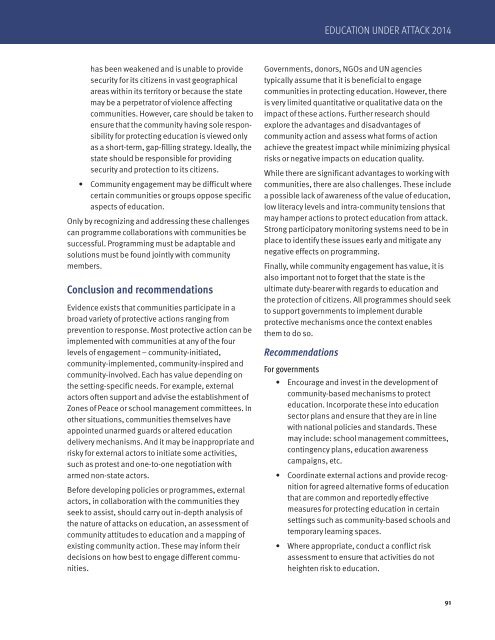Create successful ePaper yourself
Turn your PDF publications into a flip-book with our unique Google optimized e-Paper software.
EDUCATION UNDER ATTACK 2014<br />
has been weakened and is unable to provide<br />
security for its citizens in vast geographical<br />
areas within its territory or because the state<br />
may be a perpetrator of violence affecting<br />
communities. However, care should be taken to<br />
ensure that the community having sole responsibility<br />
for protecting education is viewed only<br />
as a short-term, gap-filling strategy. Ideally, the<br />
state should be responsible for providing<br />
security and protection to its citizens.<br />
• Community engagement may be difficult where<br />
certain communities or groups oppose specific<br />
aspects of education.<br />
Only by recognizing and addressing these challenges<br />
can programme collaborations with communities be<br />
successful. Programming must be adaptable and<br />
solutions must be found jointly with community<br />
members.<br />
Conclusion and recommendations<br />
Evidence exists that communities participate in a<br />
broad variety of protective actions ranging from<br />
prevention to response. Most protective action can be<br />
implemented with communities at any of the four<br />
levels of engagement – community-initiated,<br />
community-implemented, community-inspired and<br />
community-involved. Each has value depending on<br />
the setting-specific needs. For example, external<br />
actors often support and advise the establishment of<br />
Zones of Peace or school management committees. In<br />
other situations, communities themselves have<br />
appointed unarmed guards or altered education<br />
delivery mechanisms. And it may be inappropriate and<br />
risky for external actors to initiate some activities,<br />
such as protest and one-to-one negotiation with<br />
armed non-state actors.<br />
Before developing policies or programmes, external<br />
actors, in collaboration with the communities they<br />
seek to assist, should carry out in-depth analysis of<br />
the nature of attacks on education, an assessment of<br />
community attitudes to education and a mapping of<br />
existing community action. These may inform their<br />
decisions on how best to engage different communities.<br />
Governments, donors, NGOs and UN agencies<br />
typically assume that it is beneficial to engage<br />
communities in protecting education. However, there<br />
is very limited quantitative or qualitative data on the<br />
impact of these actions. Further research should<br />
explore the advantages and disadvantages of<br />
community action and assess what forms of action<br />
achieve the greatest impact while minimizing physical<br />
risks or negative impacts on education quality.<br />
While there are significant advantages to working with<br />
communities, there are also challenges. These include<br />
a possible lack of awareness of the value of education,<br />
low literacy levels and intra-community tensions that<br />
may hamper actions to protect education from attack.<br />
Strong participatory monitoring systems need to be in<br />
place to identify these issues early and mitigate any<br />
negative effects on programming.<br />
Finally, while community engagement has value, it is<br />
also important not to forget that the state is the<br />
ultimate duty-bearer with regards to education and<br />
the protection of citizens. All programmes should seek<br />
to support governments to implement durable<br />
protective mechanisms once the context enables<br />
them to do so.<br />
Recommendations<br />
For governments<br />
• Encourage and invest in the development of<br />
community-based mechanisms to protect<br />
education. Incorporate these into education<br />
sector plans and ensure that they are in line<br />
with national policies and standards. These<br />
may include: school management committees,<br />
contingency plans, education awareness<br />
campaigns, etc.<br />
• Coordinate external actions and provide recognition<br />
for agreed alternative forms of education<br />
that are common and reportedly effective<br />
measures for protecting education in certain<br />
settings such as community-based schools and<br />
temporary learning spaces.<br />
• Where appropriate, conduct a conflict risk<br />
assessment to ensure that activities do not<br />
heighten risk to education.<br />
91


